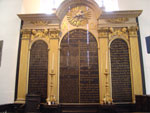 Religious
imagery was severely restricted after the reign of Henry VIII and particular
during Calvinist influence. Churches were embellished with plaques of
the Lord's Prayer and Ten Commandments but pictures were banned for their
suspected role in leading to idolatry. Catholic countries, such as the
Southern Low Countries (now Belgium) France, and Italy were rich with
images of the saints, miracles, and stories from the Bible. Secretly,
English Catholics acquired such works. Stonyhurst, then the country seat
of the Catholic Shirburn family, had a chapel. Its 1713 inventory listed
2 "large black and white" images flanking the altar. These were
presumably prints that would have been transported rolled up and undetected.
Religious
imagery was severely restricted after the reign of Henry VIII and particular
during Calvinist influence. Churches were embellished with plaques of
the Lord's Prayer and Ten Commandments but pictures were banned for their
suspected role in leading to idolatry. Catholic countries, such as the
Southern Low Countries (now Belgium) France, and Italy were rich with
images of the saints, miracles, and stories from the Bible. Secretly,
English Catholics acquired such works. Stonyhurst, then the country seat
of the Catholic Shirburn family, had a chapel. Its 1713 inventory listed
2 "large black and white" images flanking the altar. These were
presumably prints that would have been transported rolled up and undetected.
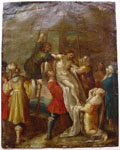
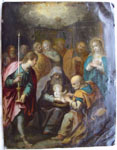 The
only paintings in the Shirburn Chapel were of small dimension (12 x 10
inches) to enable their clandestine import. These oil paintings on copper
relate to late 17th century art forms of the Southern Low Countries, possibly
Antwerp. They show the influence of Van
Dyck and Italian Schools of narrative painting. The subjects depict
the Life of Christ, including the Adoration of the Shepherds, Circumcision,
Flight into Egypt with the Holy Family Resting, Finding of the Boy Jesus
in the Temple, Christ saying Goodbye to his Mother, Christ Taken Down
from the Cross, and Christ greeting Mary Magdalene after the Resurrection
(Noli me Tangere).
The
only paintings in the Shirburn Chapel were of small dimension (12 x 10
inches) to enable their clandestine import. These oil paintings on copper
relate to late 17th century art forms of the Southern Low Countries, possibly
Antwerp. They show the influence of Van
Dyck and Italian Schools of narrative painting. The subjects depict
the Life of Christ, including the Adoration of the Shepherds, Circumcision,
Flight into Egypt with the Holy Family Resting, Finding of the Boy Jesus
in the Temple, Christ saying Goodbye to his Mother, Christ Taken Down
from the Cross, and Christ greeting Mary Magdalene after the Resurrection
(Noli me Tangere).
Included also are images of the Assumption of the Blessed Virgin and Our
Lady of Sorrows with seven swords piercing her breast, corresponding to
the tradition of the Seven
Sorrows. Pious tradition encouraged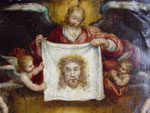 believers to try to empathize with the Virgin's
believers to try to empathize with the Virgin's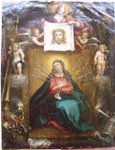 human emotions when she participated in the Presentation in the Temple,
Flight into Egypt, and Finding the Boy Jesus in the Temple, and witnessed
Christ Carrying the Cross, the Crucifixion, the Descent from the Cross,
and the Ascension when Christ finally leaves her. Above the suffering
Virgin is Veronica's veil with the bloodied face of Christ carried by
angels.
human emotions when she participated in the Presentation in the Temple,
Flight into Egypt, and Finding the Boy Jesus in the Temple, and witnessed
Christ Carrying the Cross, the Crucifixion, the Descent from the Cross,
and the Ascension when Christ finally leaves her. Above the suffering
Virgin is Veronica's veil with the bloodied face of Christ carried by
angels.
Christ also appears
as the Man of Sorrows. The saints' representations include two images
of St. Jerome, and the Martyrdom of Thomas
Becket, the feast removed from public devotion by Henry VIII, as demonstrated
in the printed Books
of Hours included in this exhibition. Many of the images seem to correspond to Jesuit
traditions of spirituality. The importance of the Circumcision, the ritual
at which Jewish males were given their names, relates to the veneration
of the Name of Jesus by the Society of Jesus).
seem to correspond to Jesuit
traditions of spirituality. The importance of the Circumcision, the ritual
at which Jewish males were given their names, relates to the veneration
of the Name of Jesus by the Society of Jesus).
Towneley
Hall, Lancashire, home of an important recusant family, imported a
copy of Rubens's Decent
from the Cross, 1612-14, Antwerp Cathedral.
